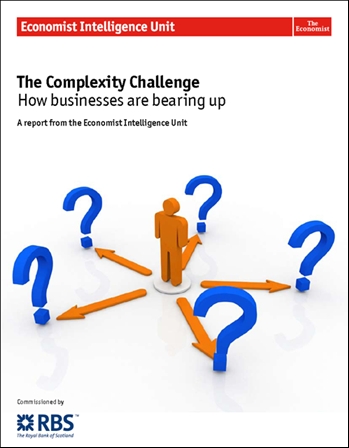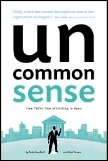Business Complexity has Grown Significantly Since the Financial Crisis

In the survey for the report titled, The Complexity Challenge: How businesses are bearing up, only 22 percent of senior executives think their organizations are well prepared to confront complexity in the future. More than one in four of them describe their firm as ‘complex and chaotic.’ The most prominent reason for the spiraling complexity is the greater expectations of customers. Complexity stemming from globalization or technology rank much lower in the list of causes.
The report also explains the wide range of measures companies are adopting to tackle the complexity; from cutting down management layers to simplifying product portfolios and processes. “It is clear from the research that complexity has become a constraint and a risk for firms,” says Abhik Sen, editor of the report. “Our study shows that some of the most successful companies today are the ones that are tackling this challenge head on by simplifying their organizations or business practices.”
Other key findings in the report include:
- The single biggest cause of complexity is greater expectations on the part of customers. Increasing customer demands for more choice in the quality and range of products and services are providing the biggest impetus to complexity. The second most cited cause of complexity in the survey is regulation.
- Complexity is exposing firms to new and more dangerous risks. Complexity has significantly increased the risk exposure of nearly one in five firms. The majority of survey respondents say complexity is affecting the ability of their firms to change business processes and is hindering the introduction of new products and services.
- Businesses are focusing on technological solutions to tackle complexity. Simplifying information technology systems seems to be the most popular way to tackle complexity in business, along with efforts to simplify or consolidate product and service portfolios. As a source of complexity, though, technology comes in only at seventh place in the survey.
- A majority of firms have an organizational structure that is adding to complexity. Nearly three in five survey respondents say that the organizational structure of their firms is exacerbating complexity. Almost half (47%) say it is difficult to work out who is responsible for what at their companies and 39 percent say that, as a result of the lack of transparency, there is considerable duplication of effort.
Click here to get your copy of The Complexity Challenge.
About the Research
The complexity challenge: how businesses are bearing up is an Economist Intelligence Unit (EIU) report commissioned by the Royal Bank of Scotland. The research is based on a worldwide survey conducted by the EIU in October-November 2010 of 300 senior executives from a wide range of industries. Approximately half the respondents represent firms with $500M USD or more in annual global revenue. Over half the respondents are C-level or equivalent and the others are directors or senior managers. A minimum of 125 respondents are from the finance function and a minimum of 125 represent functions other than finance. The Economist Intelligence Unit bears sole responsibility for the content of the report.
About the Economist Intelligence Unit
The Economist Intelligence Unit is the world’s leading resource for economic and business research, forecasting and analysis. It provides accurate and impartial intelligence for companies, government agencies, financial institutions and academic organisations around the globe, inspiring business leaders to act with confidence since 1946. EIU products include its flagship Country Reports service, providing political and economic analysis for 195 countries, and a portfolio of subscription-based data and forecasting services. The company also undertakes bespoke research and analysis projects on individual markets and business sectors. More information is available at www.eiu.com.

 “Nothing can stop someone with the right mental attitude from achieving their goal. Nothing on earth can help a person with the wrong mental attitude.”
“Nothing can stop someone with the right mental attitude from achieving their goal. Nothing on earth can help a person with the wrong mental attitude.” Gerald Adolph is a New York-based Senior Partner with Booz & Company with a specialty in strategy and operations for technology-driven businesses. His work primarily focuses on assisting clients with growth strategy, new business development, and industry restructuring. He has led numerous assignments in corporate and portfolio strategy as well as business unit strategy. In addition, he deals with value chain and industry restructuring driven by technology changes, and how companies respond to these disruptions and opportunities. Gerald is the co-author of
Gerald Adolph is a New York-based Senior Partner with Booz & Company with a specialty in strategy and operations for technology-driven businesses. His work primarily focuses on assisting clients with growth strategy, new business development, and industry restructuring. He has led numerous assignments in corporate and portfolio strategy as well as business unit strategy. In addition, he deals with value chain and industry restructuring driven by technology changes, and how companies respond to these disruptions and opportunities. Gerald is the co-author of  Paul Leinwand is a Booz & Company partner based in Chicago. He works in the consumer, media, and digital practice and focuses on capabilities-driven strategy for consumer products companies. Paul is the co-author of
Paul Leinwand is a Booz & Company partner based in Chicago. He works in the consumer, media, and digital practice and focuses on capabilities-driven strategy for consumer products companies. Paul is the co-author of  Lori Bieda is the Executive Lead for Customer Intelligence Solutions across the Americas for SAS. Prior to SAS, she was Vice President, Client Insights and DB Marketing at Canadian Imperial Bank of Commerce (CIBC) and was responsible for the creation of marketing and analytics strategy for the bank.
Lori Bieda is the Executive Lead for Customer Intelligence Solutions across the Americas for SAS. Prior to SAS, she was Vice President, Client Insights and DB Marketing at Canadian Imperial Bank of Commerce (CIBC) and was responsible for the creation of marketing and analytics strategy for the bank. StrategyDriven Podcasts focus on the tools and techniques executives and managers can use to improve their organization’s alignment and accountability to ultimately achieve superior results. These podcasts elaborate on the best practice and warning flag articles on the StrategyDriven website.
StrategyDriven Podcasts focus on the tools and techniques executives and managers can use to improve their organization’s alignment and accountability to ultimately achieve superior results. These podcasts elaborate on the best practice and warning flag articles on the StrategyDriven website.
 Andy Kanefield, co-author of
Andy Kanefield, co-author of